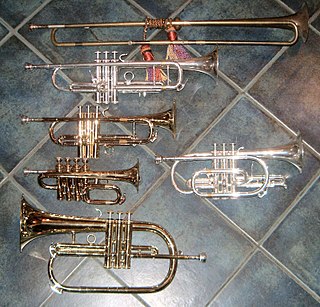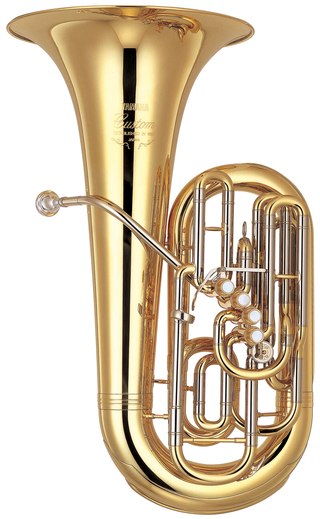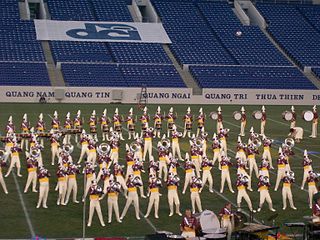
A brass instrument is a musical instrument that produces sound by sympathetic vibration of air in a tubular resonator in sympathy with the vibration of the player's lips. Brass instruments are also called labrosones or labrophones, from Latin and Greek elements meaning 'lip' and 'sound'.

The euphonium is a medium-sized, 3 or 4-valve, often compensating, conical-bore, tenor-voiced brass instrument that derives its name from the Ancient Greek word εὔφωνος euphōnos, meaning "well-sounding" or "sweet-voiced". The euphonium is a valved instrument. Nearly all current models have piston valves, though some models with rotary valves do exist.

The flugelhorn, also spelled fluegelhorn, flugel horn, or flügelhorn, is a brass instrument that resembles the trumpet and cornet but has a wider, more conical bore. Like trumpets and cornets, most flugelhorns are pitched in B♭, though some are in C. It is a type of valved bugle, developed in Germany in the early 19th century from a traditional English valveless bugle. The first version of a valved bugle was sold by Heinrich Stölzel in Berlin in 1828. The valved bugle provided Adolphe Sax with the inspiration for his B♭ soprano (contralto) saxhorns, on which the modern-day flugelhorn is modelled.

The French horn is a brass instrument made of tubing wrapped into a coil with a flared bell. The double horn in F/B♭ is the horn most often used by players in professional orchestras and bands, although the descant and triple horn have become increasingly popular. A musician who plays a horn is known as a horn player or hornist.

The pitch of a brass instrument corresponds to the lowest playable resonance frequency of the open instrument. The combined resonances resemble a harmonic series. The fundamental frequency of the harmonic series can be varied by adjusting the length of the tubing using the instrument's valve, slide, key or crook system, while the player's embouchure, lip tension and air flow serve to select a specific harmonic from the available series for playing. The fundamental is essentially missing from the resonances and is impractical to play on most brass instruments, but the overtones account for most pitches.

The saxhorn is a family of valved brass instruments that have conical bores and deep cup-shaped mouthpieces. The saxhorn family was developed by Adolphe Sax, who is also known for creating the saxophone family. The sound of the saxhorn has a characteristic mellow tone quality and blends well with other brass.

The trombone is a musical instrument in the brass family. As with all brass instruments, sound is produced when the player's vibrating lips cause the air column inside the instrument to vibrate. Nearly all trombones use a telescoping slide mechanism to alter the pitch instead of the valves used by other brass instruments. The valve trombone is an exception, using three valves similar to those on a trumpet, and the superbone has valves and a slide.

The tuba is the largest and lowest-pitched musical instrument in the brass family. As with all brass instruments, the sound is produced by lip vibration – a buzz – into a mouthpiece. It first appeared in the mid-19th century, making it one of the newer instruments in the modern orchestra and concert band, and largely replaced the ophicleide. Tuba is Latin for "trumpet".

The sousaphone is a brass musical instrument in the tuba family. Created around 1893 by J. W. Pepper at the direction of American bandleader John Philip Sousa, it was designed to be easier to play than the concert tuba while standing or marching, as well as to carry the sound of the instrument above the heads of the band. Like the tuba, sound is produced by moving air past the lips, causing them to vibrate or "buzz" into a large cupped mouthpiece. Unlike the tuba, the instrument is bent in a circle to fit around the body of the musician; it ends in a large, flaring bell that is pointed forward, projecting the sound ahead of the player. Because of the ease of carrying and the direction of sound, it is widely employed in marching bands, as well as various other musical genres. Sousaphones were originally made of brass. Beginning in the mid-20th century, some sousaphones have also been made of lighter materials such as fiberglass & plastic.

The baritone horn, sometimes called baritone, is a low-pitched brass instrument in the saxhorn family. It is a piston-valve brass instrument with a bore that is mostly conical, like the higher pitched flugelhorn and alto (tenor) horn, but it has a narrower bore compared to the similarly pitched euphonium. It uses a wide-rimmed cup mouthpiece like that of its peers, the trombone and euphonium. Like the trombone and the euphonium, the baritone horn can be considered either a transposing or non-transposing instrument.

A modern drum and bugle corps is a musical marching unit consisting of brass instruments, percussion instruments, electronic instruments, and color guard. Typically operating as independent non-profit organizations, corps perform in competitions, parades, festivals, and other civic functions. Participants of all ages are represented within the corps activity, but the majority are between the ages of 13 and 22 and are members of corps within Drum Corps International.

The mellophone is a brass instrument used in marching bands and drum and bugle corps in place of French horns. It is a middle-voiced instrument, typically pitched in the key of F, though models in E♭, D, C, and G have also historically existed. It has a conical bore, like that of the euphonium and flugelhorn. It can also be used to play French horn parts in concert bands and orchestras.
Contrabass refers to several musical instruments of very low pitch—generally one octave below bass register instruments. While the term most commonly refers to the double bass, many other instruments in the contrabass register exist.

The cimbasso is a low brass instrument that covers the same range as a tuba or contrabass trombone. First appearing in Italy in the early 19th century as an upright serpent, the term cimbasso came to denote several instruments that could play the lowest brass part in 19th century Italian opera orchestras. The modern cimbasso design, first appearing as the trombone basso Verdi in the 1880s, has four to six rotary valves, a forward-facing bell, and a predominantly cylindrical bore. These features lend its sound to the bass of the trombone family rather than the tuba, and its valves allow for more agility than a contrabass trombone. Like the modern contrabass trombone, it is most often pitched in F, although models are occasionally made in E♭ and low C or B♭.

The ophicleide is a family of conical-bore keyed brass instruments invented in early 19th-century France to extend the keyed bugle into the alto, bass and contrabass ranges. Of these, the bass ophicleide in C or B♭ took root over the course of the 19th century in military bands and as the bass of orchestral brass sections throughout Western Europe, replacing the serpent and its later upright derivatives. By the end of the 19th century, however, it had been largely superseded by early forms of the modern tuba, developed from valved ophicleides.

Marching brass instruments are brass instruments specially designed to be played while moving. Most instruments do not have a marching version - only the following have marching versions:

The contrabass trombone is the lowest-pitched instrument in the trombone family of brass instruments. While modern instruments are pitched in 12 ft F with a single slide, the first practical contrabass trombones appeared in the mid-19th century built in 18′ B♭ an octave below the tenor trombone with a double slide. German opera composer Richard Wagner notably called for this instrument in his Der Ring des Nibelungen opera cycle in the 1870s, and contrabass trombone has since appeared occasionally in large orchestral works without becoming a permanent member of the modern orchestra.

The helicon is a brass musical instrument in the tuba family. Most are B♭ basses, but they also commonly exist in E♭, F, and tenor sizes, as well as other types to a lesser extent.

The subcontrabass tuba is a rare instrument of the tuba family built an octave or more below the modern contrabass tuba. Only a very small number of these large novelty instruments have ever been built. Most are pitched in thirty-six-foot (36′) BBB♭ an octave lower than the BB♭ contrabass tuba, their fundamental note B♭-1 corresponding to a frequency of 15 Hz – such a slow vibration that it can scarcely be perceived as a note.

A horn is any of a family of musical instruments made of a tube, usually made of metal and often curved in various ways, with one narrow end into which the musician blows, and a wide end from which sound emerges. In horns, unlike some other brass instruments such as the trumpet, the bore gradually increases in width through most of its length—that is to say, it is conical rather than cylindrical. In jazz and popular-music contexts, the word may be used loosely to refer to any wind instrument, and a section of brass or woodwind instruments, or a mixture of the two, is called a horn section in these contexts.


















